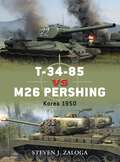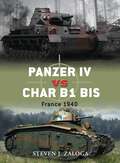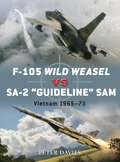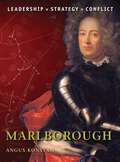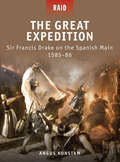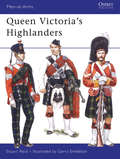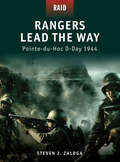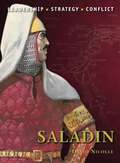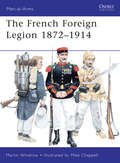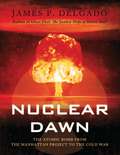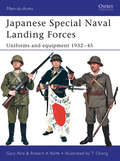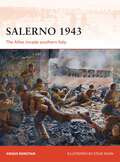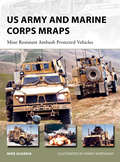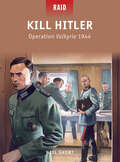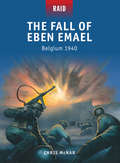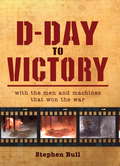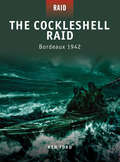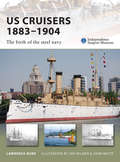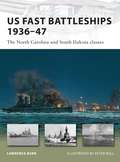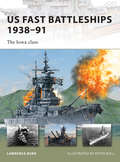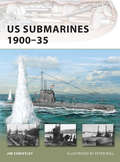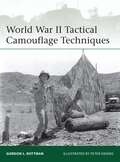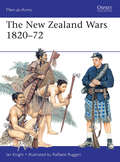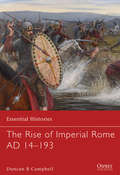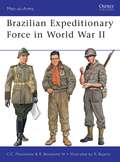- Table View
- List View
T-34-85 vs M26 Pershing
by Steven Zaloga Richard ChasemoreA hotly-debated topic amongst tank buffs is of the relative merits of the Soviet and American tanks of World War II. Using recently revealed documents, Steven Zaloga sheds light on the crucial tank battles of the Korean War as the rival superpowers' finest tanks battled for supremacy. The Soviet-equipped North Korean Peoples Army initially dominated the battlefield with the seemingly unstoppable T34-85. As US tank battalions hastily arrived throughout the late summer and early autumn of 1950, the M26 Pershing took the fight to North Korea with increasing success.From the Trade Paperback edition.
Panzer IV vs Char B1 bis
by Steven Zaloga Richard ChasemoreThe Battle of France in 1940 involved the first large-scale tank-against-tank battles in history. The massive clashes at Stonne, Hannant, and Gembloux involved hundreds of tanks on both sides, yet have faded from memory due to the enormity of the French defeat. This book examines two of the premier opposing tanks of the Wehrmacht and the French Army, the German PzKpfw IV and the French Char B1 bis. With a complete history of the design, development, and deployment of these armored fighting vehicles, the story of these great battles is brought to life in a highly illustrated format.From the Trade Paperback edition.
F-105 Wild Weasel vs SA-2 'Guideline' SAM
by Jim Laurier Peter DaviesAlthough America entered the Vietnam War with some of the world's most sophisticated combat aircraft, the majority of their missions involved conventional bombing and fighter engagements that employed quite similar tactics to those previously used in the Korean War and World War 2. The real step change in aerial fighting came with the use of air-to-air and ground-to-air missiles. Developing methods of defeating the latter involved the rapid evolution of technology and tactics which, over twenty years later, would enable the USA to win the air war over Iraq in Operation Desert Storm in a matter of hours. During the Vietnam War, the appearance of Russian SA-2 missiles around Hanoi in 1965 alarmed US officials. Initially reluctant to attack the missile sites, the increasing toll of US aircraft and the ways in which the SA-2s inhibited bombing tactics meant that new methods of dealing with the sites had to be developed quickly. Electronic reconnaissance aircraft had some success with jamming of the missiles' guidance systems at long range, but the real solution lay with an aircraft that could detect the radars at closer range, offer itself as a target to the missile sites and attack them before missiles could be launched at US bombers. F-105Fs equipped with new technology quickly became an essential addition to all USAF strike missions over North Vietnam. Using new Shrike and Standard ARM anti-radiation missiles and radar detection equipment developed by the US Navy, the F-105F and its more sophisticated successor, the F-105G, continued their hair-raising battles with North Vietnamese missile batteries throughout the rest of the Vietnam War. Here, author Peter Davies recounts the dramatic contests between these newly outfitted F-105s and the missile sites in Vietnam in a highly illustrated account, drawing on first-hand pilot experiences and technical manuals to present a full history of the technologies and tactics of both sides.From the Trade Paperback edition.
Marlborough
by Angus Konstam Graham TurnerJohn Churchill, 1st Duke of Marlborough, is one of the great commanders of history. Using his great charm and diplomatic skills he was able to bind troops from various European states into a cohesive army that won a string of victories over the French armies of King Louis XIV, the first of which was perhaps his most spectacular triumph - the battle of Blenheim. Other great victories followed, but political and social turmoil proved harder opponents to defeat. This book provides a detailed look at the many highs and lows in the career of the most successful British general of his era.From the Trade Paperback edition.
The Great Expedition: Sir Francis Drake on the Spanish Main 1585/86
by Peter Dennis Angus KonstamIn 1585, the English launched a pre-emptive strike against Spain, by attacking her New World colonies. Led by Sir Francis Drake, in command of 21 ships and 1,800 soldiers, the expedition struck first at the Canary Islands, then attacked the city of Santo Domingo and the treasure port of Cartagena. Frequently outnumbered, Drake's soldiers won an series of spectacular victories and, laden with treasure, sailed home to a hero's welcome.
Queen Victoria's Highlanders
by Gerry Embleton Stuart ReidThis book not only offers a tribute to the proud Highlander regiments who have served with distinction for over two centuries, but also offers an in-depth study of the period in which they made their name. As the British Empire dominated every corner of the globe, Queen Victoria's Highlanders served in a variety of campaigns from the Indian subcontinent to Africa. This title will study their organization, histories, and the evolution of their uniforms. Each of the famous regiments - including the Black Watch, the Gordons, the Argylls, and the Camerons - will be covered and the full glory of their romantic, tartan uniforms revealed.From the Trade Paperback edition.
Rangers Lead the Way: Pointe-du-Hoc D-Day 1944
by Steven Zaloga Howard GerrardIn the early hours of D-Day, 1944, a group from the US Army 2nd Rangers Battalion were sent on one of the legendary raids of World War II. The mission was to scale the cliffs overlooking Omaha beach and assault the German coastal artillery at Pointe-du-Hoc. It was thought that only a raid could ensure that the guns would remain silent during the D-Day landings. But allied intelligence was wrong.After climbing the cliffs under aggressive German fire and securing the battery site, the Rangers discovered that the guns themselves were no longer there. It was only due to the heroic actions of the Rangers involved that the guns were located in firing positions facing Utah beach and destroyed before they could be used. In the first of a brand new series for Osprey, this act of audacious daring is brought to life, complete with illustrated artwork, maps and rare German accounts. Taking a more critical look at the story, Steven Zaloga analyses every detail, from the intelligence failings to the boldness of the Rangers' in the face of such odds.
Saladin
by David Nicolle Peter DennisThis Osprey Command book looks closely at the early life, military experiences and key battlefield exploits of Al-Malik al-Nasir Yusuf Ibn Najm al-Din Ayyub Ibn Shahdi Abu'l-Muzaffar Salah al-Din - or Saladin as he is more commonly known outside the Islamic world - who is broadly regarded as the greatest hero of the Crusades, even in Europe. Most chroniclers present him as a man of outstanding virtue, courage and political skill. More recently, however, efforts have been made to portray Saladin as an ambitious, ruthless and even devious politician, and as a less brilliant commander than it normally thought. This book sets out to reveal that the truth is, as usual, somewhere in between.From the Trade Paperback edition.
French Foreign Legion 1872-1914
by Martin Windrow Mike ChappellThis volume covers the classic 'Beau Geste' period, of the French Foreign Legion when the corps was expanded during the most dynamic years of French imperial expansion. Legion battalions fought in the deserts and mountains of southern Algeria and Morocco, as well as in the jungles of North Vietnam, West Africa and Madagascar. Their varied uniforms and equipments for each period and theater are illustrated and examined. Written by a leading expert on the French Foreign Legion, this is a colorful introduction to the period when the Legion forged their legendary fighting reputation.From the Trade Paperback edition.
Nuclear Dawn
by James DelgadoWhen President Obama and others say they want to end America's dependence on foreign oil, the vision is usually presented in terms of "a new Manhattan Project." So what really was the Manhattan Project? According to James Delgado, at the start of the project in 1942, the element plutonium only existed in microscopic quantities. By June 16, 1945, the date of the world's first nuclear bomb test, America had a fully-operational plutonium industry capable of producing hundreds of pounds of the fissionable material. In just three short years, nuclear weapon technology had progressed from infancy to the world stage. Delgado, the co-host of the National Geographic Television series "The Sea Hunters," tells the breathtaking story of the original Manhattan Project and its aftermath. While most previous authors have focused on either the scientific or the social history of the events, Delgado's is the first to spotlight the military and political phases of the atom bomb. In crisp prose, he covers the background of the bomb in the labs in Europe, Britain, and America, but the story picks up speed after the bombing of Pearl Harbor and the declaration of war by America.While most people recognize Robert Oppenheimer as the father of the bomb, readers of Nuclear Dawn will be surprised to learn that gave birth more in the sense that Henry Ford gave birth to the auto industry. In Delgado's narrative, Oppenheimer's role as master organizer and astute business manager is emphasized. What's more, few before Delgado have understood how deeply involved the US Army was in the project. From the very beginning, the program was run by army officers, financed by secret wartime military funds--to the tune of billions of dollars, staffed by army engineers and scientists, and made possible by army bureaucracy. Delgado also shows that without the army's ordnance expertise at Los Alamos, Oppenheimer's team could not have turned nuclear technology into a workable bomb.Several other unique aspects of Nuclear Dawn turn on the military's role in the project. For example, Delgado tells the full story of the army air force's 509th fighter battalion, which was headed by an iconoclastic colonel named Paul Tibbets. Tibbets' battalion consisted of over 1,200 pilots and crew dedicated to a singular task: delivering an atomic bomb to Japan. Delgado tells how as part of their training, the Utah-based crews would fly practice sorties to Cuba and back, over and over again. Another little-known aspect of the Manhattan Project drawn out be Delgado is the post-war bickering that quickly arose between the army and navy over who would control the bomb. James Delgado's new book fills a very important gap in our understanding of the enormous changes that the United States military underwent during WWII.From the Hardcover edition.
Japanese Special Naval Landing Forces
by Christa Hook Gary NilaThe spearhead of Japan's assault landing operations both in China pre-Pearl Harbor, and in US and British territory post-Pearl Harbor, was provided by the Special Naval Landing Forces - 12 numbered battalion-size Imperial Japanese Navy units. They garrisoned a number of the islands which the US Marines then had to re-claim in some of the bloodiest battles of the Pacific War of World War II (1939-1945). These included the infamous battles of Iwo Jima and Okinawa. This book provides a comprehensive treatment of the elite force which has never before been examined in such detail in English, covering weapons and equipment as well as uniform and insignia.From the Trade Paperback edition.
Salerno 1943
by Steve Noon Angus KonstamIn mid-September 1943, as the opening move of the Allied campaign to liberate the mainland of Italy, an Anglo-American invasion force landed on the beaches of the Gulf of Salerno, only a few dozen miles to the south of Naples. Italy had just surrendered, and the soldiers in the landing craft prayed that the invasion would be unopposed. It was not to be. The Germans had seized control of the Italian-built beach defences, and were ready and waiting. What followed was one of the bloodiest battles of the whole Mediterranean campaign - a ten day contest where victory hung in the balance. Over 80,000 British and American soldiers waded ashore at Salerno, and after bitter fighting they managed to establish a narrow and vulnerable bridgehead. The British enclave near Salerno was separated from the American sector around Paestum by a river, and German-held strongpoints. All attempts to link up the two parts of the bridgehead were thwarted by the German defenders, who were being reinforced faster than the Allies. Then the Americans were nearly flung back into the sea by a ferocious German counterattack, as the German commander on the spot used his veteran armour and Panzergrenadiers to deadly effect. Although driven back towards the beach, the Americans rallied and grimly held on, and the crisis passed. The ferocious ten-day battle at Salerno was eventually decided by a combination of Allied reinforcements, and secondary landings in support of the beleaguered Salerno bridgehead. The battle for Salerno changed the course of the campaign - by its end it was clear that wherever possible the Germans were going to fight for every inch of ground in Italy, and the campaign was not going to be the easy victory the Allied commanders had hoped. Using documentary records, memoirs and eyewitness accounts from all sides, Angus Konstam recreates the battle day by day, hour by hour. His methodically researched account offers a fresh perspective on a decisive battle that has largely been neglected by British and American historians in recent years.
US Army and Marine Corps MRAPs
by Henry Morshead Mike GuardiaDeployed to Iraq and Afghanistan, the newest land warfare system in the United States Army and Marine Corps, the Mine Resistant Ambush Protected (MRAP) vehicle has undeniably proved its value. Designed to meet the challenges of operating in a counterinsurgency environment, the MRAP has taken survivability to a new level. MRAPs are currently manufactured by three companies: BAE Systems, Navistar International Military Group, and Force Protection Inc. Each company manufactures an MRAP according to one of three classifications set by the US Department of Defense: Category I, Category II, or Category III. The Category I MRAPs are designed for urban combat. Category II covers the MRAPs designed for convoy security, medical evacuation, and explosive ordnance disposal. The Category III MRAP performs the same function as Category II but is designed to carry more personnel.Since their introduction in 2007, MRAPs have performed remarkably in the asymmetric warfare environment. Their unique design and survivability characteristics have saved the lives hundreds of soldiers who otherwise would have been lost to landmines or IED attacks. As with any combat system, however, the MRAP is not without its drawbacks.
Kill Hitler - Operation Valkyrie 1944
by Peter Dennis Neil ShortAt the end of 1943 the SS and the Gestapo arrested several prominent Germans involved in plotting to overthrow Adolf Hitler, including Dietrich Bonhoffer, Klaus Bonhoffer, Josef Muller and Hans Dohnanyi. Others under suspicion, such as Wilhelm Canaris and Hans Oster, were dismissed from office in January 1944. Major Claus von Stauffenberg emerged as a leader of the group of German Army officers opposed to Nazi rule, and began to plan for the assassination of Adolf Hitler, Hermann Goering and Heinrich Himmler, and for a takeover by the Army. Once these three prominent Nazis had been killed, the plan called for troops in Berlin and other major German-controlled areas, commanded by his co-conspirators, to seize key government buildings, telephone and signal centres and radio stations. At least six attempts were aborted before von Stauffenberg decided on trying again during a conference attended by Hitler on 20 July 1944. It was decided to abandon the plans to kill Goering and Himmler at the same time, and to focus solely on removing the Führer. Von Stauffenberg carried the bomb in a briefcase and placed it on the floor beside Hitler before excusing himself to make a phone call. The bomb exploded killing four men in the hut. Hitler was injured but survived the bomb blast. The plan that called for Ludwig Beck, Erwin von Witzleben and Erich Fromm to take control of the German Army and declare martial law was abandoned when it became known that Hitler had survived the assassination attempt. In an attempt to protect himself, Fromm organized the execution of Claus von Stauffenberg and two other conspirators, Friedrich Olbricht and Werner von Haeften, in the courtyard of the War Ministry. It was later reported that von Stauffenberg died shouting "Long live free Germany". As a result of the 20 July Plot, the new chief of staff, Heinz Guderian, demanded the resignation of any officer who did not fully support the ideals of the Nazi Party and presided over the Army Court of Honour that expelled hundreds of officers suspected of being opposed to the policies of Adolf Hitler. This removed them from military jurisdiction and left them to be sentenced by Roland Freisler and his fanatically pro-Nazi People's Court. Over the next few months most of the group including Wilhelm Canaris, Carl Goerdeler, Julius Leber, Ulrich Hassell, Hans Oster, Peter von Wartenburg, Henning von Tresckow, Ludwig Beck, Erwin von Witzleben and Erich Fromm were either executed or committed suicide. It is estimated that nearly 5,000 Germans were executed as a result of the events of the July Plot. Hitler ordered that the leaders should have a slow death. They were hung from meathooks with piano wire, and their executions were filmed and later shown to senior members of both the NSDAP and the armed forces.
The Fall of Eben Emael - Belgium 1940
by Chris Mcnab Peter DennisIn early May 1940, the fortress of Eben Emael was a potent sentinel over the Belgian-Dutch borderlands. The fortress covered 75 hectares on the surface, had 5km of tunnels underground and was studded with bunkers, gun turrets and casemates. Add a garrison of 1,200 men and the natural protection of 60m-high canal walls, and Eben Emael gave the impression of near-impregnability. Yet on 10 May just 78 elite airborne soldiers managed to defeat this fortress in an operation of unprecedented tactical skill. Deployed by glider onto the very top of the fortifications, they utilized elite training, fast movement and specialist explosives to destroy many of the gun positions and trap much of the garrison within the fortress. Simultaneously, three other assault detachments conducted high-risk glider operations to capture critical bridges over the Albert Canal. By the end of 11 May, following the arrival of German infantry reinforcements, Eben Emael was in German hands. This Eben Emael RAID title tells the complete, fascinating story of this unique action.
D-Day to Victory
by Stephen Bull Impossible PicturesBeginning with a look at D-Day itself, this book begins by analyzing the deadly fighting on the beaches as the Allies launched the first successful cross-Channel invasion in 900 years and concludes with the final victory amidst the ruins of Berlin. Now, almost 70 years afterwards, this book reveals the realities of the final year of the war through the words and recollections of the last surviving veterans. Using their own words and accounts it describes the terror of soldiers facing down a German tank, assaulting a machine-gun post or surviving an artillery barrage on the long, arduous road to Victory-in-Europe. Drawing upon expert analysis and no-holds-barred recreations, it also shows the devastating effects of the weaponry used on a daily basis in an astonishing sequence of full-colour images while historic imagery bring to life the last great battles between the Allies and Nazi Germany from the torturous struggle for control of Falaise to the desperate fighting in the Bulge and the final push to the heart of the Reich. Like no other book before, World War II Frontline Heroes, reveals how ordinary men and women fought and survived throughout the extraordinary final months of World War II.
The Cockleshell Raid: Bordeaux 1942
by Howard Gerrard Ken FordOn the night of December 7, 1942, five canoes were launched off the mouth of the Gironde river, each containing a pair of British commandoes tasked with slipping into the port of Bordeaux and destroying as many of the merchant ships as possible. Only two of the canoes made it to the target, but it was enough. Five enemy ships were badly damaged in the attack. It then became a game of cat and mouse for the surviving commandoes in their attempt to get back to Britain. Some of the men made it to Gibraltar; others were caught and executed. Author Ken Ford gives a blow-by-blow account of one of the most daring raids of World War II, which badly upset the flow of material into Germany, and which gave the British public a much needed victory.
US Cruisers 1883-1904
by Ian Palmer Lawrence BurrBy the end of the Civil War the US Navy was the most advanced in the world, but in subsequent years America's naval might dwindled. However, in the 1880s a 'New Navy' was born and at the forefront of its fleet were the mighty cruisers. Naval historian Lawrence Burr details how these cruisers allowed America to rebuild their navy, exploring the design and development of these ships. Placing these advances in context, through vivid accounts of how US cruisers performed in the Spanish-American War of 1898, notably at Manila Bay and Santiago, he investigates the emergence of the US Navy as a major power. Illustrated with early photographs and full-colour artwork, this is a concise history of the birth and development of a modern navy that was the precursor to the development of modern steel fleets around the world.
US Fast Battleships 1936-47
by Peter Bull Lawrence BurrThis volume details the design, construction, and operation of the first six of the ten US fast battleships, two of the North Carolina class and four of the South Dakota class. These six battleships were all authorized in 1936 and were the first vessels built in the US since 1923. Consequently, these ships benefitted from enormous technological leaps, with improvements in ship design, power, armor, armament and the single most important improvement the use of radar guided fire control helping to change the course of the war in the Pacific. Packed with first-hand accounts, battle reports, and specially created artwork this book tells the story of these war-winning vessels.From the Trade Paperback edition.
US Fast Battleships 1938-91
by Peter Bull Lawrence BurrIn 1938, the United States abandoned the constraints imposed by the Washington Treaty and began work on a new class of super-battleships. This book covers the design, construction, and employment of the four Iowa-class battleships, the largest in the American fleet. During World War II, they served as guards for the aircraft carriers and their bombardments provided cover for the numerous landings in the Pacific. At the war's end, the Japanese signed their surrender on the decks of an Iowa-class battleship, the USS Missouri. After World War II, the ships continued to serve, providing support during Korea, Vietnam, and even the first Gulf War. This book tells the full story of the greatest of the American battleships.From the Trade Paperback edition.
US Submarines 1900/35
by Peter Bull Jim ChristleyThis book introduces the reader to the early years of US submarine development and operation during the first third of the 20th century. It was in this period of growth and change that the submarine moved from a small vessel of limited range and tactical strength to a far ranging force. It also covers the little-told story of the United State's submarine force during World War I, and the lessons they learned that would be passed on to future generations of submariners.
World War II Tactical Camouflage Techniques
by Peter Dennis Gordon RottmanThis book explains and illustrates the actual materials and techniques adopted (both successfully and unsuccessfully) by tactical units - i.e. the concealment of personnel, weapons, equipment, field positions, and movement by infantry riflemen and weapons crews, artillerymen, and vehicle crews. It covers all areas and seasons in the European and Mediterranean theaters of operations, for the US, British, German, and Soviet armies. It includes camouflage of the person, personal equipment, and weapons; natural materials and "expedient" techniques; issued camouflage materials such as nets, ponchos, etc; the principles of camouflaging equipment and vehicles, of positioning and terrain integration, the effects of light and shadow, and the use of decoy and dummy positions. Featuring meticulous full-color artwork and specially selected period photographs, this absorbing study casts new light on the camouflaging techniques developed by the major armies of World War II on a host of European battlefields.
The New Zealand Wars 1820-72
by Raffaele Ruggeri Ian KnightBetween 1845 and 1872, various groups of Maori - the Polynesian people who had inhabited New Zealand since medieval times - were involved in a series of wars of resistance against British settlers, which in many ways mirrored the American Indian Wars. Like some Native Americans, the Maori had a fierce and long-established warrior tradition (epitomized today by the intimidating haka war-challenge performed by the All Blacks rugby team), and lived in tribal communities dispersed throughout rough and thickly wooded terrain. Subduing them took a lengthy British Army commitment, only surpassed in the Victorian period by that on the North-West Frontier of India.Warfare had been endemic in pre-colonial New Zealand - in contests over territory and group prestige, and in generations-long feuds - and Maori groups maintained fortified villages or pas. The small early British coastal settlements, also widely dispersed, were tolerated, and in the 1820s a chief named Hongi Hika travelled to Britain with a missionary and returned laden with gifts. He promptly exchanged these for muskets, and began an aggressive 15-year expansion at the expense of neighbouring tribes. When new waves of major British settlement arrived between the 1840s and 1860s, competition over the available productive land caused increased friction and clashes. British troops were shipped in, and fought a series of essentially local wars in both North and South Islands over more than 25 years. However, some Maori groups always allied themselves with the Europeans, in pursuit of ancient enmities with their neighbours.By the 1860s many Maori had acquired firearms and had perfected their bush-warfare tactics. Their defences also evolved, with conspicuous log fortifications giving way to deep entrenchments less visible and vulnerable to artillery. The British, too, were adapting their uniforms, equipment and tactics to broken-country fighting in the bush, and employing more portable artillery and mortars. In the last phase of the wars a religious movement, Pai Maarire ('Hau Hau'), inspired remarkable guerrilla leaders such as Te Kooti Arikirangi to renewed resistance. This final phase saw a reduction in British Army forces as operations were increasingly taken over by locally recruited constabulary and militia units. European victory was not total, but led to a negotiated peace that preserved some of the Maori people's territories and freedoms; in modern times this has allowed a real (if sometimes strained) progress towards a genuinely unified national identity.
The Rise of Imperial Rome AD 14-193
by Duncan CampbellWhen Augustus (r. 27 BC-AD 14) came to the throne as the first emperor of Rome, he began to bring order to the chaos that almost 20 years of civil war had wrought. Areas that had been added piecemeal to the Roman Republic, from Spain and Gaul to Dalmatia, needed to be restructured as provinces of the empire, while in the East, Augustus reorganised Asia Minor and Syria, and held the Parthian empire in check with cunning diplomacy. The foundations of the empire were thus laid by Augustus, and his aspirations for world conquest were passed on to his successors, who would strive to defend, expand and consolidate the empire after his death. Under Trajan (AD 98-117) the empire reached its largest extent - some 6.5 million square kilometres. Its presence in much of present-day Western and Central Europe gave the area a lasting legacy in a range of areas, from legal matters to languages and from architecture to religious belief.In this book ancient-warfare specialist Duncan Campbell explores the course of the wars that ensued as successive emperors sought to extend the empire, from Claudius' conquest of Britannia (AD 43) and Domitian's campaigns on the Rhine (AD 83) and the Danube (AD 89, 92), through Trajan's Dacian Wars (AD 101-03, 105-06) and Parthian War (AD 117), to Marcus Aurelius' Marcomannic Wars (AD 167-75, 177-80), as well as the Jewish Wars (AD 66-74 and AD 132-36). The period covered in this book ends with the consolidation of the Roman frontiers along the Rhine and Danube - 'this far and no further' - and uneasy peace with the Parthian empire, wracked by its own internal troubles. The murder of the emperor Pertinax in AD 193 was to usher in a period of instability and civil war, dominated by the mighty Septimius Severus (r. AD 193-212).This book provides a summary of the strengths, limitations and evolving character of the Roman army during the first two centuries AD, as well as those of the forces of Rome's enemies across the Rhine and Danube in Germany and Romania, and in the East, in the form of the Parthian empire of Iraq/Iran. The characters and achievements of the soldiers and civilians who fought Rome's enemies and administered the new provinces carved out in war are brought to life in vivid detail. Fully illustrated with photographs depicting the emperors, their armies and enemies, and the remains of Roman fortifications and public buildings, plus informative full-colour maps, this is the epic story of the wars waged by a succession of emperors during the period in which Imperial Rome reached its zenith.
Brazilian Expeditionary Force in World War II
by Ramiro Bujeiro Cesar MaximianoIn the English-speaking world, it is generally unknown that a volunteer Brazilian Expeditionary Force (FEB) fought alongside the US Army in Italy from mid-1944 until the end of the war. This was in effect a light infantry division, consisting of three infantry regiments augmented with artillery and light armour. It was supported by a Brazilian Air Force contingent of a light reconnaissance squadron as well as a P-47 Thunderbolt-equipped fighter squadron. Although all weapons, uniform, kit and equipment were either American-supplied or American models, there were distinctive Brazilian adaptations to uniforms and other key pieces of kit. This is a seriously researched volume on a little-studied subject matter complete with a range of previously unpublished photographs and specially commissioned artwork plates.
